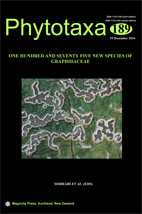Abstract
Twelve new species of the lichen family Graphidaceae are described from NE Thailand, namely Fissurina niveoalba, with warty paraphyses tips, muriform ascospores and the lack of secondary lichen substances; F. phuluangii, with 2–8 muriform ascopores and the production of stictic and hypostictic acids; Graphis subdussii, distinguished by unbranched, straight ascomata with entire labia, a completely carbonized exciple and transversely septate, up to 170 µm long ascospores; G. subinsulana, with conspicuous, prominent ascomata, a laterally carbonized exciple, single, muriform ascospores and norstictic acid; Leiorreuma hypomelaenoides, which differs from L. hypomelaenum by the absence of hypostictic acid; Phaeographis caesiodiscoides, distinguished by radiately branched immersed to erumpent ascomata with uncarbonized exciple and muriform, brown ascospores; P. loeiensis with numerous irregularly branched, clustered ascomata, with an uncarbonized exciple and 8–11-septate brown, transversely septate ascospores; P. neotricosoides which differs from P. neotricosa by the lack of neotricone, instead producing stictic acid; P. phurueaensis, distinguished by a clear hymenium, 5–7-septate, dark-brown ascospores and especially by producing stictic and norstictic acids, both as major metabolites; P. schizolomoides, distinguished by conspicuous prominent ascomata with a white-pruinose disc surrounded by a whitish thalline margin, and brown, submuriform ascospores; P. siamensis, which is separated from P. brasiliensis by the production of stictic acid and small, 3-septate ascospores; and Platygramme subarechavaletae, which is distinguished by inconspicuous ascomata with a concealed disc, an apically to laterally carbonized exciple and submuriform ascospores.

